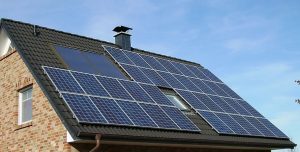For an allergy sensitive individual the priority for building green should be put on healthy home methods. For a less sensitive and more energy conscious individual, the priority should be put on solar design methods. What about the individual who wants to address both issues? Can the differences between these 2 building strategies be bridged?

As a healthy home consultant, let me try to answer this question as non-biased as possible by comparing a couple of ways that they conflict. Let’s start with the biggest one.
- A successful Solar design requires the use of gas appliances and mechanical systems in order to keep the energy efficiency peaked and the Kilowatt load down. (Especially if using Photovoltaic systems.) Gas use in a healthy home is discouraged for a couple of reasons. The obvious being combustion related problems. The not so obvious is the smell of the gas or propane. These two fuels in their raw form (prior to resale) do not have the peculiar odor you smell when they are used in your home. This odor comes from a pesticide additive, which is supposed to alert you to leakage of the gases into your indoor air.
A question I have proposed to the state government is-Can the additive be eucalyptus or cinnamon, or some pleasant odor instead of a toxic chemical? If so, then I see that the bridge can be joined between these two building methods when it comes to appliance use.
 When it comes to combustion issues, To minimize the negative effects of the byproducts in the indoor environment, all combustion appliances should be properly vented and inspected by a professional annually. Gas stoves should be vented outdoors with a proper exhaust fan, which should be used when cooking.
When it comes to combustion issues, To minimize the negative effects of the byproducts in the indoor environment, all combustion appliances should be properly vented and inspected by a professional annually. Gas stoves should be vented outdoors with a proper exhaust fan, which should be used when cooking.
- Solar design relies on natural ventilation (opening of windows) rather than mechanical ventilation (controlled air flow) for the same reasons as stated above- mechanical systems create a large Kilowatt load. WNC is a temperate rain forest. We are located in the extreme moisture belt rather than the mixed or moderate moisture belt. High humidity days are just as common as low humidity days in WNC.
High humidity air travels differently than low humidity (dry) air. Humid air, when traveling through a wall or window is not a fluid flowing air, but a heavy, slow flowing air. It travels to the nearest porous material and nestles in there like a sponge due to its high moisture content. So the idea of using a whole house fan as a channel for air to travel through the house, while your windows are left open- is not the most viable strategy for high humid climates.
If your windows are open on a typical spring, summer or early fall day when the outdoor humidity is above 60%, then the air in your home will also be above 60%. And as that slow air travels to the nearest building material (drywall, fabric, and carpet just to name a few), mold spores are created. For the allergy sensitive person, this is a health hazard.
…

